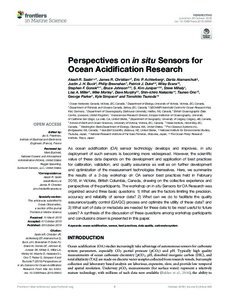Perspectives on in situ Sensors for Ocean Acidification Research.

View/
Average rating
votes
Date
2019Author
Sastri, Akash R.
Christian, James R.
Achterberg, Eric P.
Atamanchuk, Dariia
Buck, Justin J. H.
Bresnahan, Philip
Duke, Patrick J.
Evans, Wiley
Gonski, Stephen F.
Johnson, Bruce
Juniper, S. Kim
Mihaly, Steve
Miller, Lisa A.
Morley, Mike
Murphy, Dave
Nakaoka, Shin-ichiro
Ono, Tsuneo
Parker, George
Simpson, Kyle
Tsunoda, Tomohiko
Metadata
Show full item recordAbstract
As ocean acidification (OA) sensor technology develops and improves, in situ
deployment of such sensors is becoming more widespread. However, the scientific
value of these data depends on the development and application of best practices
for calibration, validation, and quality assurance as well as on further development
and optimization of the measurement technologies themselves. Here, we summarize
the results of a 2-day workshop on OA sensor best practices held in February
2018, in Victoria, British Columbia, Canada, drawing on the collective experience and
perspectives of the participants. The workshop on in situ Sensors for OA Research was
organized around three basic questions: 1) What are the factors limiting the precision,
accuracy and reliability of sensor data? 2) What can we do to facilitate the quality
assurance/quality control (QA/QC) process and optimize the utility of these data? and
3) What sort of data or metadata are needed for these data to be most useful t.....
Journal
Frontiers in Marine ScienceVolume
6Issue
Article 653Page Range
6pp.Document Language
enSustainable Development Goals (SDG)
14.3Essential Ocean Variables (EOV)
Inorganic carbonBest Practice Type
Best PracticesStandard Operating Procedure
DOI Original
10.3389/fmars.2019.00653Citation
Sastri, A,R,. et al (2019) Perspectives on in situ Sensors for Ocean Acidification Research. Frontiers in Marine Science, 6:653, 6pp. DOI: 10.3389/fmars.2019.00653Collections
The following license files are associated with this item:
 Repository of community practices in Ocean Research, Applications and Data/Information Management
Repository of community practices in Ocean Research, Applications and Data/Information Management
